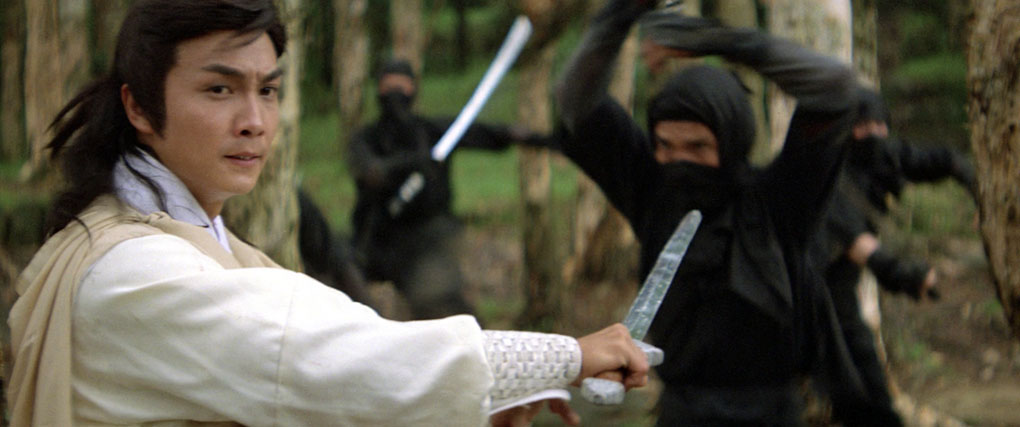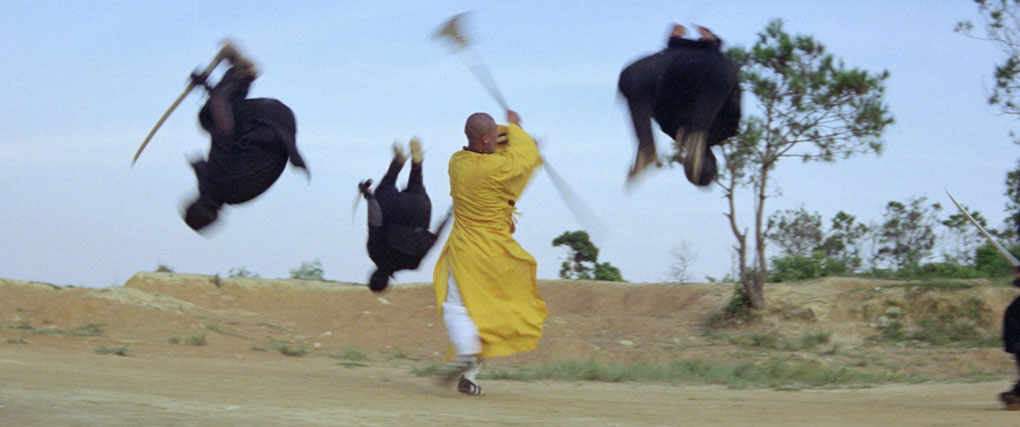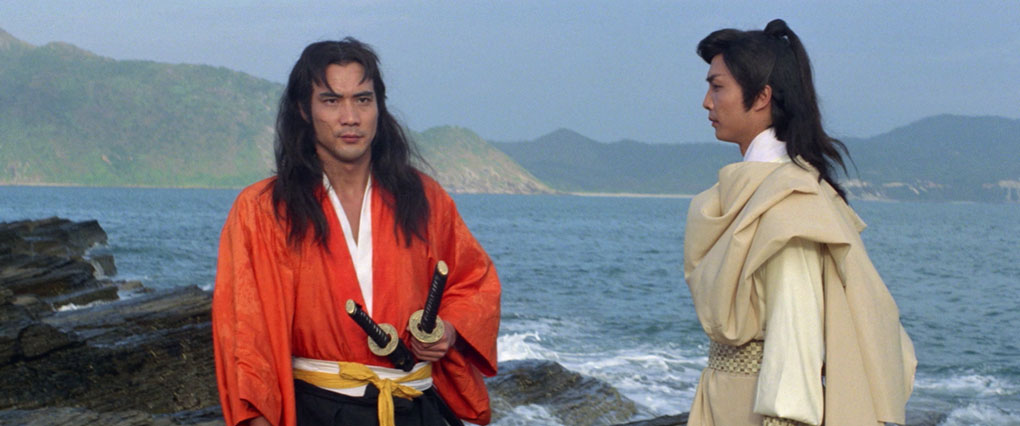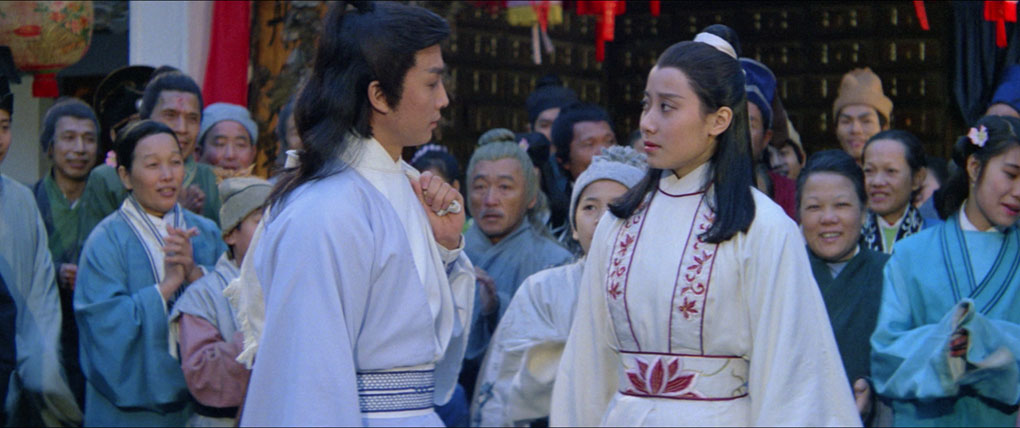|
As a long-standing fan of martial arts cinema, I long ago conceded that the genre is not exactly known for the complexity of its storylines, whose primary function is to move the film from one combat sequence to the next. The essentials of the narrative can usually be summed up in a single, brief paragraph, but even with that in mind, try this for a plot summary for the 1983 Duel to the Death, written by an anonymous contributor to the film’s IMDb page: “The best sword master from China vs the best sword master from Japan. Who will win?” And in a way, that really does cover the basics. It turns out, however, that there’s more to it than that.
In 16th century Ming Dynasty China, a competition is held every ten years between the greatest swordsman from China and his Japanese equivalent in the duel to the death of the title, with both men fighting for the honour of their respective nation. The Chinese contestant this decade is Bo Ching Wan (Damian Lau Chung-Yan), a good-natured warrior who has been training for years with Shaolin monks and has received further instruction from… well, I’ll get to that fellow in a minute. His Japanese counterpart is a skilled samurai named Miyamoto Ichiro (Norman Tsui Siu-Keung) and with fight traditionally held on the ancestral grounds of Master Han (Paul Chang Cheung), whose family were instrumental in developing the kung fu now practiced by Chinese combatants, it’s to this location that both men head.
Still doesn’t sound like much? Well, I’ve not yet mentioned Hsia-Hau Sing Lam (Flora Cheung Tin-Oi), whom we and Bo first encounter when she teaches two samurai (Stephen Yip and Wilson Tong) a seriously sharp lesson after they murder a Chinese puppeteer for being disrespectful to the Japanese. Shortly after she’s finished there, she’s out in the desert riding up to Miyamoto and pestering him to take her on as a pupil. “I don’t teach women,” he tells her after the two do brief battle, and continues his journey. Sing Lam is later revealed to be Han’s lethally skilled daughter, and by the time Bo and Miyamoto reach Han’s abode, she and Bo have fought side-by-side in combat and are starting to get rather fond of each other. Floating around the periphery, meanwhile, is Kenji (Eddie Ko Hung), a Japanese monk who has been sent to guide Miyamoto, but whose behaviour suggests that he may be more than he seems.

And then there are the ninjas. Man, I don’t know where to start with these guys. In the opening scene, they spring out of the woodland and rush into a Shaolin temple to take chemical rubbings of bamboo scrolls on which the secrets of the monks’ fighting techniques are carved. As they attempt to make their getaway, they are ambushed in a battle that spills onto a nearby beach, where the ninjas hurriedly bury the copied documents and transform themselves into suicide bombers, each leaping onto one of the monks to take him out in a spectacular explosion. That’s not the last we’ll be seeing of these chaps. Every now and then, they pop back into the story, first to retrieve the buried scrolls and then to assault just about everyone else of significance in the story, the fanciful nature of their attacks suggesting that they have supernatural powers. Seriously, these men and women – and we know from one sequence in which one of them is unexpectedly stripped naked during combat that both genders are represented here – are capable of such insane feats that it’s hard to see how any regular fighter could stand a chance against them. They leap through the air in defiance of gravity, burrow through the earth like those worms in Tremors, vanish and reappear a few feet away, and even combine into a single giant ninja that causes the ground to shake with every step. At one point, a Chinese warrior walking alone at night is attacked from the air by a flock of them attached to huge kites, a sight so inventively outrageous that I choked on my coffee. It got to the stage where you would need to be a fortune teller on acid to have a chance of predicting what they would do next.
Ninjas aside – and I have to admit, they’re a whole heap of mad fun – what intrigued me most about the story is the way it usurps one particular Hong Kong martial arts film trope. As soon as I heard that the titular battle was to be between a white-dressed and likably upbeat Chinese warrior I’d just met and an as-yet unseen fighter from Japan, I inwardly groaned just a little. Hong Kong martial arts films in which the Japanese are portrayed as unspeakably evil bad guys are two-a-penny, and while there is very real historical justification for this animosity, such one-dimensional villains do even a solid martial arts film no favours. So imagine my surprise when then film nips over to Japan (actually Korea, but still surprisingly authentic in its detail) to introduce Miyamoto as he cheerfully helps his young nephew win at kendo practice and joins his friends for a jovial goodbye piss-up, then sticks with him while he fights and kills a fearsome attacker that turns out to be his master delivering a final lesson to his star pupil before his departure. It’s a tragic encounter that has an emotional impact on Miyamoto and provides us with welcome confirmation that the two warriors are not going to be painted in black-and-white terms. Bo’s master, on the other hand, is a comical, tree-swinging hermit whose primary skill appears to be falling on his arse from a considerable height and who seems to be being set up as the film’s awkwardly misplaced comedy relief. I genuinely wondered what Bo could possibly have learnt from this old fool. Thankfully, he isn’t in the film for long.

So yes, there’s a lot more to the plot than that compact IMDb summary suggests, but any martial arts movie still lives or dies by the quality of its action scenes, and on this front Duel to the Death really does soar. The swordplay here is blisteringly performed and choreographed, and while I’ve complained before about films whose fights are constructed largely in the edit, the sometimes blinding speed of the editing here is most effectively used to further accelerate the pace and sell the sometimes dizzying nature of the wuxia acrobatics as somehow plausible. The film is also surprisingly bloody in places, with a couple of amputations and an outrageous decapitation that sees the head of the victim speared on a tree branch, where it delivers a parting warning before expiring. As a whole, this has to be one of the finest showcases for the talents of editor Peter Cheung Yiu-Chung, a veteran of Hong Kong action cinema whose extraordinary filmography includes the likes of Fist of Fury, Way of the Dragon, Hapkido, Zu: Warriors from the Magic Mountain, and a string of titles for Jackie Chan, including Project A, Police Story and Armour of God. Danny Lee Yau-Tong and Lau Hung-Chuen’s colour scope cinematography is also consistently superb, its breathless and often mobile coverage of the action sharing space with visually striking static shots, one of which – the extraordinary image of a group of captured individuals dressed in brightly coloured attire and suspended in space by a web of ropes – prompted me to jump in my seat and let out a yelp of surprise, genuinely unsure what I was watching anymore.
I have little doubt that cultural differences are at the root of my confusion when it comes to male characters initially mistaking Sing Lam for a man, a trope I’ve come across before in the genre and that I was only made aware of here when it’s commented on specifically by Bo. What follows is the only sequence that made me squirm just a little, as Sing Lam acts on Bo’s suggestion that she should dress more like a woman, shot as a series of romantically framed and scored, soft-focus close-ups of her slipping into clothing that will apparently better showcase her femininity. Hmm. What I did appreciate is the equal standing shown to Bo and Miyamoto, two supposed foes who clearly respect each other’s skills and who you just know will eventually team up to battle an initially unspecified foe. Genre convention dictates that they will have to fight each other nonetheless, a conflict that Bo by then no longer has a taste for until Miyamoto commits his only act of cruelty, enacted solely to initiate a fight that he still feels honour-bound to engage in, whatever his feelings are for his opponent.

The sheer skill and panache with which the film is assembled and with which the action is staged make a mockery of the fact that this was stunt and fight choreographer (a role he also shared here with Lau Chi-Ho) Ching Siu-Tung’s first feature as director. Four years later, he would direct the action-horror classic, A Chinese Ghost Story, while his skills as an action choreographer were put to similarly jaw-dropping use in the likes of Dragon Inn (on which he also worked uncredited as director), Shaolin Soccer, Hero and The House of Flying Daggers. In Duel to the Death, there’s almost a sense that he was determined to showcase everything he could do both as a filmmaker and an action choreographer, one who could take the wildest and most seemingly preposterous ideas and somehow make them work on screen. The even-handed presentation of the Chinese and Japanese opponents is refreshing in a genre that still holds old grudges, and the swordplay is some of the most athletically performed, furiously choreographed and energetically filmed that you’ll find anywhere in martial arts cinema of the day. It’s a thrilling, hugely impressive and surprisingly fatalistic example of what Hong Kong action cinema once did better than anyone, and as an entertainment is an absolute blast.
One thing I quickly discovered is that I shouldn’t make snap judgements the 2.40:1 transfer on Eureka’s Blu-ray based solely on the opening night time scene. What I noticed immediately is that the black levels here have more of a blue-black feel, one that’s hungry enough for detail to gobble up anything that falls into the many pools of shadow. The image still has a lively, punchy feel, but this doesn’t prepare you for the daylight scenes that follow, whose contrast balance is sublime and whose colour is so rich and vibrant that I had to push my eyeballs back into my head. Sourced from a new 2K restoration, for the most part the image here is crisp and detailed, but there is some variance on this score, presumably dictated by the condition of the material used for the restoration, which has left some shots looking noticeably softer than others. There’s no trace of any former wear and tear, however, and dust spots are rare. It may fluctuate a little, but at its best, this is a very fine transfer.
You have the choice of watching the film with the original Cantonese dialogue track and optional English subtitles or the English dub that doubtless accompanied the film’s initial international release. Both are Linear PCM 2.0 mono and have the expected range restrictions, which can make the higher notes of the music score sound a little shrill, but the dialogue is still clear and the wooshes and clangs of the swordfights are very much as I remember. The Cantonese track is a little louder than the English track, but does have a slight background hum that’s not detectable on the English one. Obviously, the Cantonese track is the more authentic of the two, with the English dub having the usual collection voices that are mismatched to the characters they are dubbing and the dialogue has been altered to provide English phrases that run for as long as a character speaks. That said, I’ve heard a lot worse.
Audio Commentary with Asian Film Expert Frank Djeng
When does this man take a breath? Impossibly active Asian film expert, Frank Djeng, whose commentary on Eureka’s recent Blu-ray of One Armed Boxer was a bit of a belter, is back to cram something like three hours’ worth of information, observation and analysis into a mere 87 minutes of screen time. You’ll need to be paying attention to catch everything he says, so speedy is his delivery at times, something he apologises for at the end but rightly justifies as necessary to deliver all of the information that he had on the film. And he has so much to tell us. The expected background on the actors, the director, the editor, the cinematographer and the composer is punctuated by welcome explanation of cultural elements that might not register with Western audiences, a breakdown of the techniques used to fake the wilder stunts, and translation of any Chinese characters that appear on screen. We get a guide to which shots were filmed on location in Korea and which were shot in the studio or on location in Hong Kong, the surprising news that ninjas were first introduced to a Hong Kong audience by the Japan-set James Bond film, You Only Live Twice, and no opportunity is missed to plug other Eureka martial arts Blu-ray releases. I’ll second that.

Manfred Wong Interview (32:28)
Screenwriter Manfred Wong – whose voice we only get to hear briefly because spoken translation of his words is provided as we go by Frank Djeng – looks back at becoming a scriptwriter for TV while in college, how that led to a full-time screenwriting job and the year-long process of writing Duel to the Death with first-time feature director Ching Siu-Tung. He intriguingly claims that he never volunteers original ideas but instead asks directors to tell him what they want and he’ll deliver it, and that he had no idea how to end Duel to the Death, the original script for which he still has from when the title was the somewhat less dramatic ‘Ninja’. He offers his opinion on how many lines of dialogue a script should have (“Of course, if it’s a Woody Allen film, there are way more lines”) and the current state of Hong Kong martial arts cinema, and having written over 200 scripts to date, he admits that he now sometimes sees his old films on DVD and asks himself in surprise, “I wrote this?”
Norman Chui Siu-Keung Interview (18:57)
An archival interview with still cool-looking actor Norman Tsui Siu-Keung, who plays Japanese samurai Miyamoto in the film. He reveals, without a whiff of false modesty, that he used to be a stock exchange accountant and was persuaded to try acting because he was so handsome, and recalls his action movie training – a tad ironically, given his role in this film – at the hands of Japanese kendo masters. He talks about his work on Duel to the Death, handily explains the difference between the Chinese and Japanese way of fighting with swords, and recalls the hair-raising wire work in the climactic clifftop battle. I’m not sure when this was filmed, but it’s framed 16:9 and appears to be in HD.
Flora Cheong-Leen Interview (9:26)
An archival interview with actor Flora Cheong-Leen, the only woman in an otherwise almost exclusively male cast (other female characters are essentially bit parts or extras). She recalls returning to Hong Kong after training as a dancer with the Royal Ballet in the UK and almost accidentally getting cast in a TV production that led to an exhausting slew of movie contracts. She looks back at Duel to the Death as one of her favourite film experiences, a production on which she fell in love with action moviemaking, although she does admit to crying a lot and being comforted by her two male co-stars. Her comments on why she seems to prefer working around men might ruffle a few feathers, particularly her suggestion that women think and talk too much. Really? Again, I’m not sure when this was filmed, but it was clearly sourced from a:3 standard definition original, and is dated by the gimmicky games that have been played with the framing, a hugely annoying trend that I hope we’ve seen the last of.

Alternate Opening / Closing Credits (3:54)
The opening closing credits from the English language version of the film. The opening titles mirror those of the Hong Kong version, being black text on a white background, but there’s no getting around the fact that beautifully hand-calligraphed Chinese characters are a lot more attractive that printed English text with its bog-standard serif font. Whoever oversaw the English language closing credits, meanwhile, must have fallen asleep on the job. On the Hong Kong original, the film cuts to its final shot, over which the credits roll, with the shot freeze-framing halfway through the credit roll. On the English language version, the final shot freezes almost as soon as it appears, then sits with the music running for a staggering 38 seconds before the credits start to roll.
Stills Gallery #1
37 production stills whose quality varies a little, but the best are very impressive. Half of them are colour and the other half monochrome, the latter reproduced at half screen size for some reason
Stills Gallery #2
17 screens of posters, press notes and other promotional artwork.
Original Hong Kong Trailer (3:20)
Plenty of swordplay, coupled with what feels like all of the more outrageous ninja action in a trailer that has no time for dialogue and just lets rip. Unsurprisingly for a Hong Kong action trailer from the period, it’s peppered with disconnected textual claims like “Pioneering Cinematography” and the like.
US Home Video Trailer (1:48)
Originally made for the US Tai Seng laserdisc release and reconstructed especially for this edition, this trailer is loaded with narrated explanations of the plot and the characters, plus lots of positive comments about the film’s many qualities. Some of the textual graphics have almost a science fiction movie feel.
Booklet
The lead essay here is a perceptive and enjoyable one on the film, its director and his collaborators by film critic/historian and filmmaker, James Oliver. Commentary and Manfred Wong voiceover provider, Frank Djeng, makes a further contribution with a reproduction of his liner notes for the above-mentioned laserdisc release. Also included are credits and promotional materials for the film, plus the usual viewing notes.
Intermittently barmy and frankly rather wonderful, Duel to the Death is a hell of a debut feature for a man who went on to become one of Hong Kong’s most notable directors and action choreographers. I enjoyed it immensely, and the presentation here, despite some minor inconsistencies in the source material, is often glorious, and is supported by a solid set of special features. Highly recommended.
|